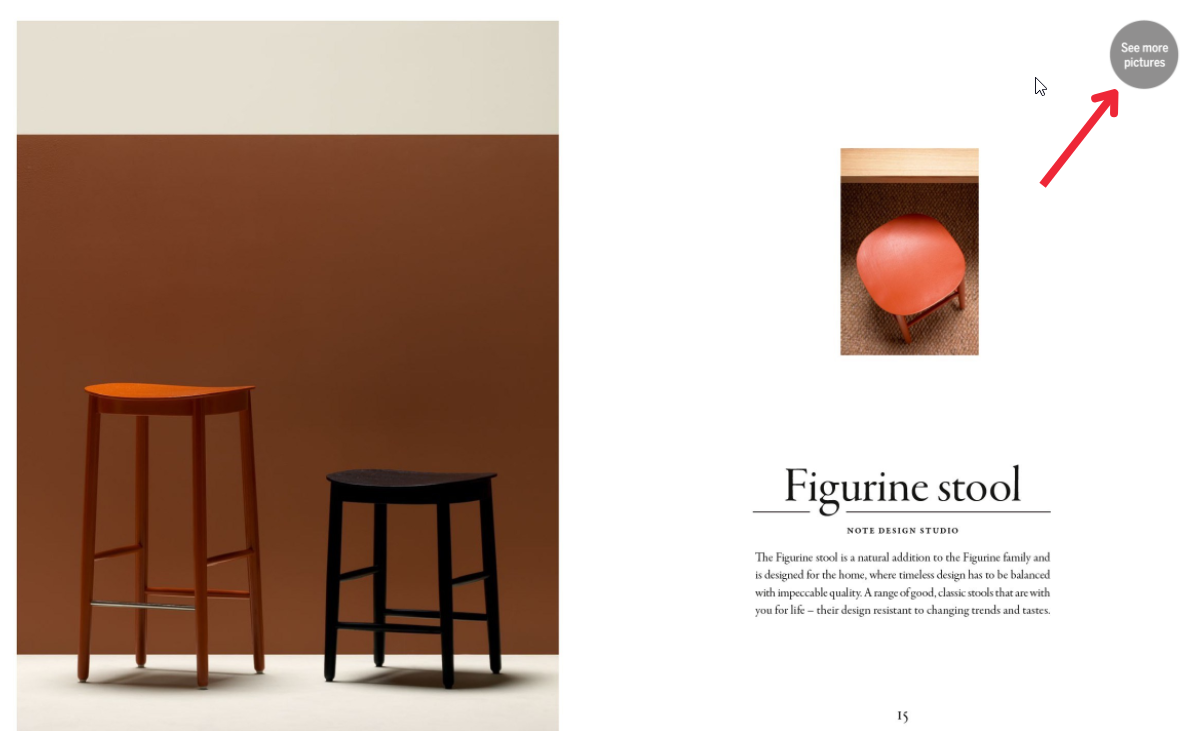7 strategies to designing an online catalog that converts

1: Use CTAs
A well placed call-to-action can make a huge effect on converting browsers into customers. They invoke a clear action for the readers and it gives them a logical next step.
Luckily, this is quite easy to do. The first and most important thing you need to look for is the color contrast of the CTAs with the background and adding animation to make the online catalog CTAs stand out:
Another thing you can do is make the CTAs bigger. But be careful not to irritate the customer if there are already too many products on the page.
Keep in mind that you need to find the right balance in the online catalog.
2: Enable checking out
When making the leap from print to online catalogs, it's also extremely important to provide a way to check out.
It could be...
- Direct integration on your website and ecommerce
- Exporting all products in the online catalog basket to your webshop
- External links to your website
- Creating a wishlist
- Send to friends or family by email
- WhatsApp or Viber messaging
One of the best ways to turn visitors into customers in your digital catalogs is by making it super easy to shop directly from the catalog.
We are impatient online, and the more steps we have to take to buy, the less likely it is that we swing out our credit card.
Here, you can see how Oriflame fully integrated their online catalog with their website and ecommerce.
3: Enrich the catalog with product videos
You can't ignore videos in your marketing efforts. Viewers are between 64-85% more likely to purchase from you, when they've seen one of your product videos (source).
So it's a good idea to invest in videos and add them to your online catalog.
Here, you can see how a video can be used to enhance the experience in the online catalog:
4: Use powerful product images
When it comes to online catalogs it's critical to catch the user’s attention. You can do this in different ways, but one of the best ways is to use images.
As the shopper can't pick up the product and see what it feels like, product images are key in selling online.
Make sure your online catalog images are large, high-resolution and highlight the key features of the product.
Just like Oriflame does:
5: Show products from different angles and variants
Furniture retailer FOGIA really highlights the importance of making multiple images available in their online catalog.
On several pages, they also have an icon with "See more pictures". This opens up a carousel showing the product in more colors and from more angles. This makes it easier to imagine how the product looks in real life and showcases the different options.

6: Limit the number of products per page
You might get away with 30 products per page on your printed catalog. But not online.
You need to keep the user focused and engaged. And, despite what you might think, online catalog pages overflowing with products will do exactly the opposite.
Fewer products per page helps the user focus more. Plus, without printing costs to consider there is no limit to spreading your products across additional pages!
Here, you can see how the display of few products in an online catalog gives them more space to shine and entice:
7: Create compelling product descriptions
Now that you have more space in your catalog, take advantage of it by providing more value for your readers with product descriptions.
They helps the reader understand the meaning behind the product or brand. In short, it makes the reader want to keep exploring.
A good example of this is consumer goods retailer COOP with their online spring catalog. Product descriptions are accompanied with stories of the designers behind them, incorporating a little bit of personality and storytelling.

Conclusion
Now it's time for you to take the next step towards creating online catalogs. Use all the available tools to improve your online catalogs and achieve your sales and marketing goals.
It doesn't have to be difficult or time-consuming. Often even very small changes can help give your visitors that engaging experience that turns them into paying customers.
Start with the ones most relevant to your business. You can always add on more features to make the digital experience in your online catalog even more compelling and engaging.
Need to get the full overview?
Explore our Complete Guide to Digital Catalogs (All You Need To Know!)
Continue Reading

The impact of inspiration in online retail

The biggest digital leaflet mistake (and how to fix it)
Your catalogs will be in good hands
- We have over 20 year’s experience working with digital catalogs
- Our dedicated team of experts are on hand to guide you to success


